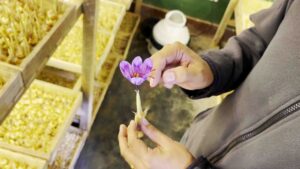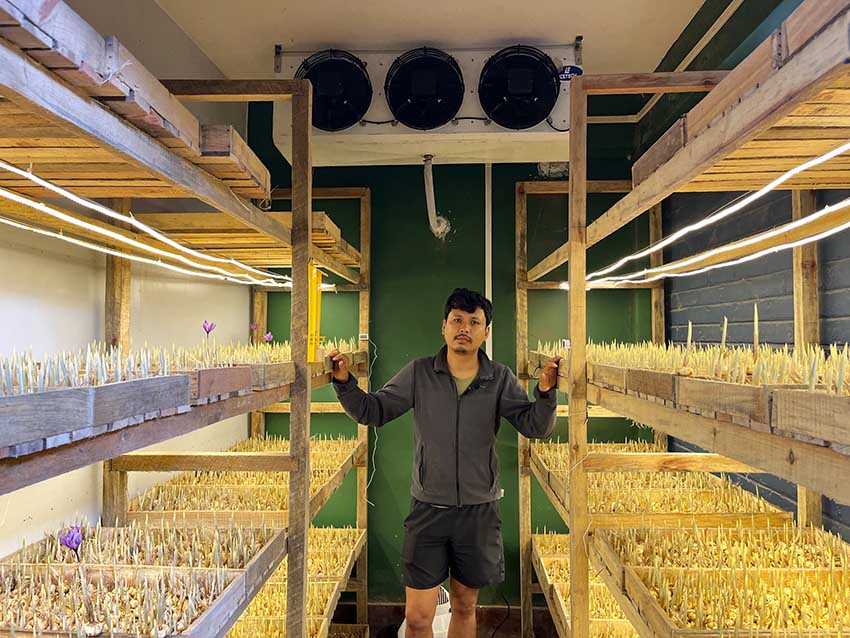In what can be termed a groundbreaking initiative for Manipur, Tomba Khundrakpam, a sound recordist and theatre production manager from Lipham Khunou Makha Leikai in Imphal, has ventured into a new frontier. He has begun cultivating saffron, which is considered to be the costliest spice in the world, using innovative aeroponic methods. In Manipur, saffron farming is a novel endeavor, making his initiative groundbreaking. Tomba’s initiate marks the first attempt to grow saffron—often referred to as “Red Gold” – within the state. Known for its extensive uses in culinary, medicinal, and cosmetic fields, saffron commands an impressive market value, with each kilogram fetching upwards of ₹5 lakh due to the intensive labor and expertise required for its cultivation. Manipur has fostered many entrepreneurs who, despite various challenges, have launched numerous ventures and achieved success in the state. Tomba is one of them. His initiative is relatively new, and most people in Manipur are still unfamiliar with saffron, let alone its significance.
Every day, though Tomba goes out and does his job as a sound recordist and production manager in theater, he remains fueled by a passion for innovation. Unfortunately, Manipur’s weather is not quite suitable for saffron farming, but he wishes to pursue it nonetheless. Consequently, he transformed a modest area at his residence, roughly the size of a small shop in India’s alleys, into a fully functional lab where he conducts aeroponic farming. Despite lacking a formal education in saffron farming, he navigates the internet and watches available instructional videos. While he was in Dubai for a few days, browsing videos about various businesses in that country, he first encountered a video on saffron farming. Since Dubai’s temperature is significantly higher than that of Manipur, it filled Tomba with hope to start the business. Consequently, he enrolled in a workshop organized by an expert from Chandigarh. After completing the virtual lessons, he acquired the essential skills to embark on saffron farming. Since no one else had ventured into saffron cultivation in Manipur, he had to approach it on an experimental basis. Determined to push the boundaries, he initiated his lab-based farming with one sole objective in mind: to produce premium-quality saffron.
In India, saffron is cultivated in the fertile regions of Kashmir, primarily in Pampore, as well as in select areas of Kishtwar and Pulwama. The climate and soil conditions in these regions are considered ideal for this spice, making Tomba’s initiative in Manipur a bold experiment. If successful, his endeavor could pave the way for a new agricultural model in Manipur, inspiring other farmers to explore non-traditional, high-value crops.
In an exclusive conversation with Imphal Review of Arts and Politics, Tomba Khundrakpam shared the details of his journey into saffron farming. Holding a saffron flower and gently separating its leaves, he pointed to the vibrant red stigma and explained, “The essential part is the stigma—the deep red, fibrous center of the saffron flower. Each flower has only three filaments, which are what matter. A gram of saffron costs around ₹500 in India.”

In the Indian market, offline or online, saffron is sold; however, there is a rising concern about the authenticity of available saffron. Raising a cautionary note, Tomba emphasized, “Finding genuine saffron can be challenging. Many buyers don’t know how to identify authentic saffron, so the market is unfortunately flooded with substitutes.” As he delved into the nuances of saffron’s marketing potential, Tomba shared insights into the marketing strategies and distribution channels available to saffron producers. “Saffron is highly sought after in the pharmaceutical industry due to its medicinal properties,” he noted. “Large pharmaceutical companies are prime buyers, as they use it in the production of various health supplements and treatments.”
He highlighted that, beyond pharmaceuticals, the spice has significant appeal to the food and beverage industries, both domestically and internationally, underlining its diverse uses. “Saffron has diverse uses—not just as a spice, but also as a natural food colorant,” he explained. “Most food manufacturers rely on artificial colorants, but the demand for natural options is growing, and saffron is prized for its vibrant color and rich antioxidant content.”
Narrating the process of farming the spice, Tomba explained that saffron is seasonal, with processing beginning in August and cultivation taking place in November. Surprisingly, he noted that countries like Israel have started cultivating saffron four times a year, though they have not disclosed the methods used. He continued that saffron production in India does not meet domestic demand, leading the country to import saffron from Iran and other nations. Tomba began his farming in June 2024.
“Saffron is naturally grown in Pampore in Jammu and Kashmir, as the region’s temperature and weather are suitable for this spice. However, due to climate change and other environmental issues, production levels have decreased. Consequently, many people have started farming it using indoor methods. I haven’t seen this effort in Manipur or the northeastern states, so I have started farming this year,” he continued.
He began his farming in a 7 x 10-foot area and has spent around four lakh rupees, including the setup, buying seeds, and other expenses. Since the weather in Manipur does not match that of Pampore, his lab is equipped with various tools, including Air Cooled Chiller, to maintain a similar temperature throughout the year. He is pursuing this venture on an experimental basis and plans to expand in the coming years with the hope of making a profit.
When prompted to share the hurdles he confronts during this journey, he said, “I primarily face technical challenges. Given my reliance on electricity for saffron cultivation, frequent power outages present a significant obstacle. I have not faced significant issues so far, but I anticipate that if there are power cuts in the area, it could lead to serious hiccups in my venture. Currently, I experience low-voltage electricity, which I manage, but I have various tools in my lab, so if equipment like the AC fails, it may take time for servicing personnel to arrive and repair it. Farming would face major problems if the electricity is out or the AC is not functioning for more than four hours. If I have backup power, I can manage. After three or four seasons, I hope to keep the business rolling.”
Manipur has produced many entrepreneurs. Like many of them who are navigating the complex landscape of entrepreneurship in Manipur, Tomba finds himself yearning for governmental intervention. The cultivation of saffron, a crop revered for its rarity and value, is fraught with challenges that extend far beyond mere agricultural labor. It necessitates a considerable financial outlay to initiate the process, which is compounded by the myriad risks associated with establishing a business in this northeastern state.
In Manipur, the entrepreneurial spirit is often stifled by a harsh reality: the specter of extortion looms large, inflation continues to soar, and essential services remain woefully underdeveloped compared to their counterparts in the more prosperous regions of mainland India. Moreover, the procurement of raw materials, critical to the farming of saffron, presents yet another formidable obstacle. In a milieu where accessibility and reliability are paramount, Tomba’s resolve is commendable.
Driven by an indomitable spirit, Tomba has embarked on an ambitious journey in saffron farming, fully aware of the challenges that lie ahead. While the months and years may bring numerous adversities, he remains steadfast in his belief that each challenge is a valuable lesson. Viewing setbacks as opportunities for growth, Tomba is committed to turning these experiences into stepping stones toward success. In the high-stakes world of saffron cultivation, his resilience shines through, as his journey transcends mere agriculture—it fosters hope and tenacity in a demanding environment.













10 thoughts on “Manipur Man Ventures into Saffron Farming, Aiming to Earn ₹5 Lakh per Kilo”
I am proud of you brother
God bless your talented mind
Keep it up eyamba
God bless your journey
I wish for my side
Yaifare
Iam from kerala india . A farmer by profession . Would like to go for saffron planting in closed space of 2000 Sq feet. But have no basic idea could u pls guide me to do that. Any contact class to ettend
Indeed a very very bold initiative and attempt. Being in the nascent stage and also lots of challenges that are already ‘sensed’ by the entrepreneur himself, it would be wise to publicise only after three seasons of successful cropping. It should invite ‘many’ pseudo-entrepreneurs who would pose ‘threat’ in his SWOT analysed new venture!
I had read just now , Ih heared and read about safforn. From deep within of my heart❤ encourage your spirit to go forward and sure u will be a great👍 entrepreneur God bless you and our kanleipak YAIPHARE.
I had read just now , Ih heared and read about safforn. From deep within of my heart❤ encourage your spirit to go forward and sure u will be a great👍 entrepreneur God bless you and our kanleipak YAIPHARE.
It’s a good start keep it up
Very good job 👍
News oina onthok piradi fagani website se professional mannaba.
Its awonderfull job which nobody can belief your hard work.May God be with you forever.keep it up bro.you are adare person in this state….
Comments are closed.